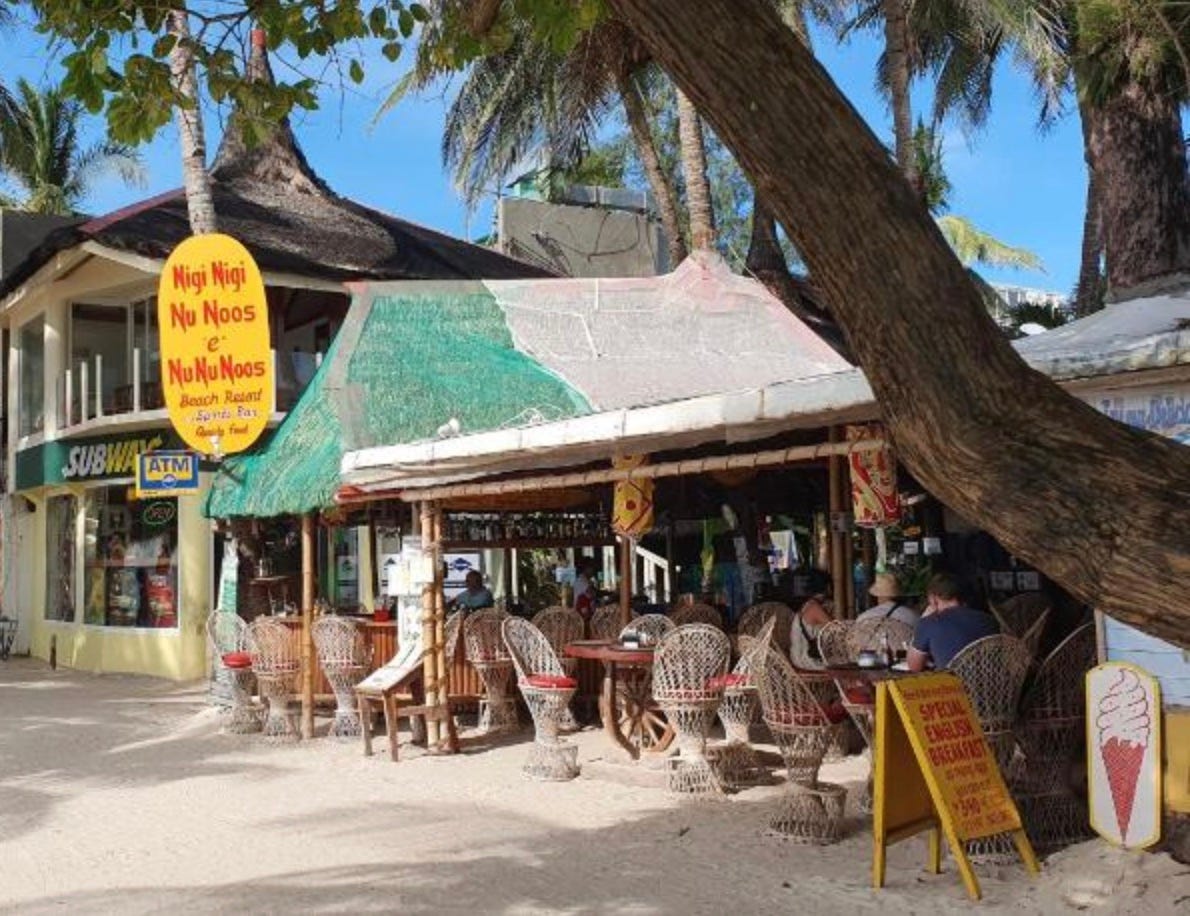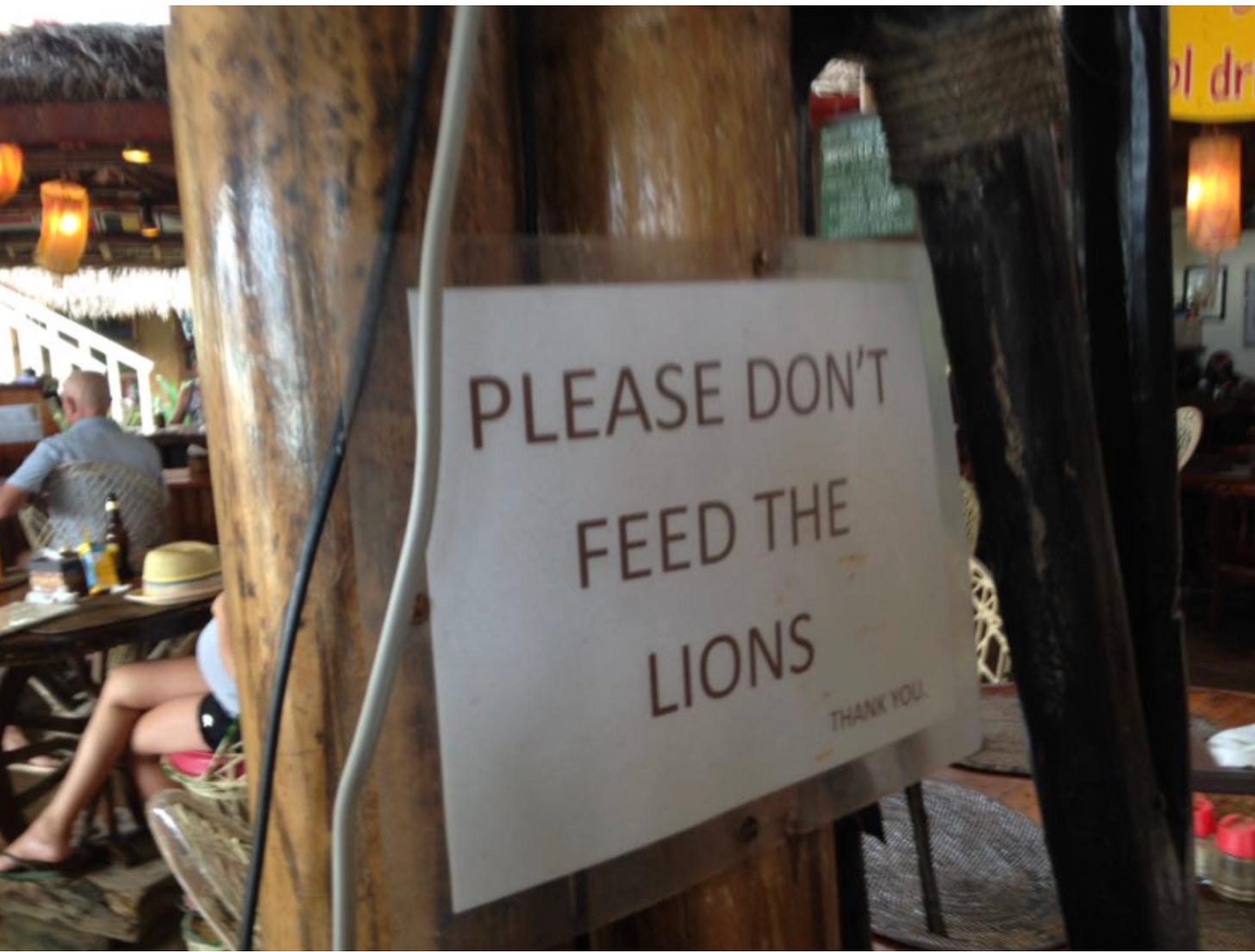Nigi Nigi Nu Noos is the most popular restaurant on Boracay, an island paradise in the Philippines. Thousands of people on the beach during daytime, but come evening they're all hungry. And though there are many many restaurants to choose from, none pack em in like Nigi. I wondered why.
And as I had nothing better to do, I wandered around to see if I could figure it out. A rational person might suggest that food quality, price, and location were main factors, but as an island holiday resort, prospective diners simply did not have time to evaluate the numerous restaurants based on taste. It would take a month or more to visit them all and so diners must “guess” at least on their first visit.
A location that caught my eye was a single building with two restaurants, one on either side. They shared a kitchen so food quality could not be a factor. They had similar menus with similar prices. Location, food, and price were nearly identical and yet, one was packed to capacity while the other was empty.
How else were they different?
Many ways. I ticked them off my list and continued the same survey around town. Some curious patterns emerged. It turned out that food, location, and price, were less important than more primitive, even prehistoric factors. They may not apply everywhere, but on the tropical beaches of Boracay these are the rules:
---
1. Follow the Crowd
People are herd animals, and nowhere more so than in the selection of restaurants. If it’s crowded it must be good, goes the thinking. And so busy places stay busy and empty places stay empty. But this factor can only explain so much, because all the restaurants begin empty. But if I were advising restaurants, I would tell them to “prime” the crowd, even if it means seating staff to get the ball rolling.
---
2. Open Space is Bad
Every restaurant I saw with a large rectangular open space was empty. There’s something uncomfortable about it. If people are attracted to crowds, these open areas are like “anti-crowds.” Perhaps triggering a primitive alarm, like a gazelle alone on an African plain being too easy a target for lions. Meanwhile restaurants with hiding places, like walls, corners, booths, dividers, plants, posts, sculptures, and other people all performed better.
---
3. Fire is Good
The ancient appeal, camaraderie, and safety of the campfire, even in small doses such a token candles draw people in. Even lights or signage that ‘flickers’ seems to trigger the same response. All or very nearly all busy restaurants had a trace of flame or lively light. I saw only one with candles and no customers, and that one had a large open rectangular room.
---
4. Low Entries
This one surprised me, but any restaurant with a wide open ‘walk-in-wherever’ entrance or an oversized door performed poorly. Low doorways, even ones that require ducking, consistently outperformed tall ones. A safety response perhaps. Like entering a tent or cave.
---
5. Large Outdoor Signage
Bold and simple. At an angle or perpendicular to walkway best. At eye level or slightly higher. Signs over doorways nearly useless. Behind glass might as well be invisible.
---
6. Personality Sells
A name that shows personality performs much better than descriptions or puns. Good names include Nigi Nigi Nu Noos, Crazy Crepes, and Zed’s Beach Bar. Those were all full. While places with descriptive names like VIP Bistro, Boracay Cafe, and Bite Club were all empty.
---
7. Silence is bad.
Silence is what happens in the forest when a predator is spotted. Silence tells prospective diners to run for their lives.
---
8. Color
Red is the best. Blue, green and turquoise are generally bad. Exactly why I do not know but perhaps red representing fresh meat while green is spoiled. Natural tones and materials, wood, leather, and stone work best for the environment. We are drawn to nature.
---
9. Permeability
A transition between outside and inside, ideally a patio with seating. But anything that creates an in between zone to soften the entrance. From an open door to a sculpture outside, even just a sign that sticks out can make a difference. A flat wall with a closed door facing the sidewalk is doom.
---
10. Value Perception
Price didn’t seem to play as much role as price “perception.” For example The VIP Bistro had white leather chairs right on the beach with a fancy sound system pumping out tasteful techno. Very VIP looking, but empty.
Meanwhile just a few steps up the beach, Nigi Nigi Nu Noos was a bamboo shack with a dirt floor and 80’s pop blaring from a boom box. Lowbrow. But full. Both served burgers and bar food but… Nigi Nigi Nu Noos was MORE expensive.
Either diners were prioritizing something other than price, or if they were price sensitive they chose Nu Noos because it looked cheaper, and it sounded cheaper, even though it wasn’t. Perception trumped price.
On my checklist for success Nigi Nigi Nu Noo appeared to be doing everything right, and it is after all the most popular place in town. Perhaps it was an accident, or perhaps they were tuned in to the primitive urges and prehistoric behavior patterns that drove our ancient dining habits.
As I got up to leave I did notice a sign hanging from a bamboo post, “Please don’t feed the Lions.”
Nigi knows. Or I guess Nigi Nu...





